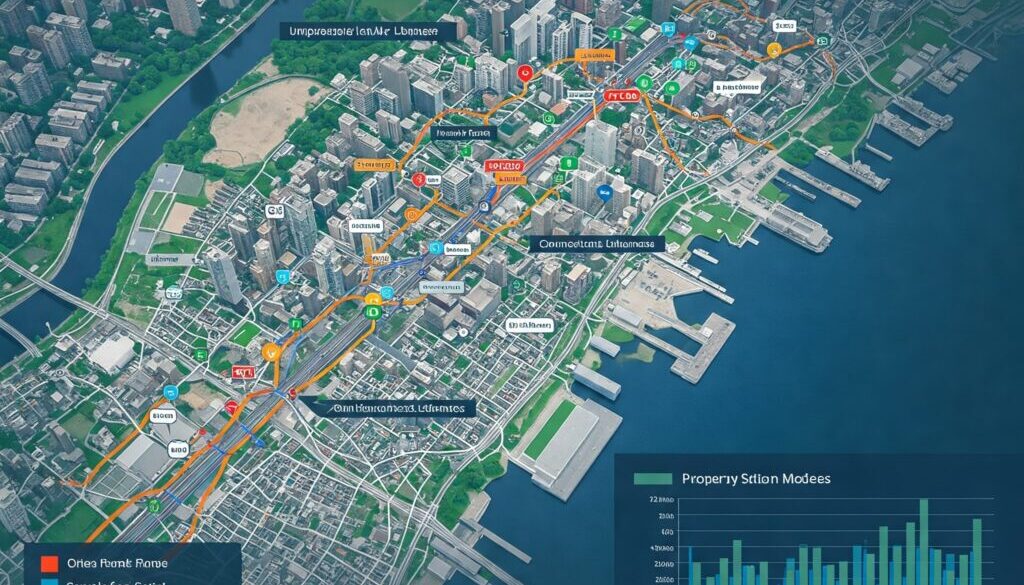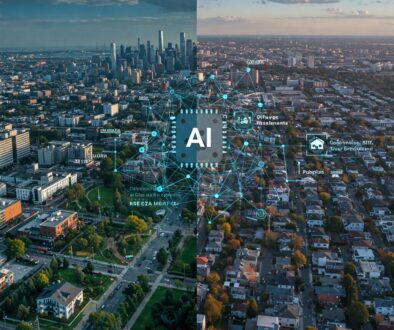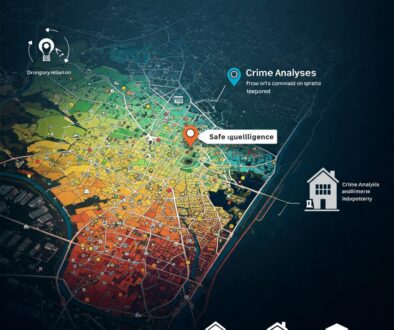Transportation Development Impact on Real Estate: AI Prediction Models
Few infrastructure developments impact real estate values as profoundly as transportation improvements. From subway extensions to new highway interchanges, bike lane networks to high-speed rail stations, transportation infrastructure can dramatically transform accessibility, desirability, and ultimately the value of surrounding properties.
Yet predicting exactly how specific transportation developments will affect real estate values has traditionally been more art than science. Investors rely on general assumptions, historical comparisons, and intuition to estimate potential impacts, often with mixed results. The reality is that transportation effects are highly contextual, varying based on numerous factors from neighborhood characteristics to implementation specifics.
In 2025, AI-powered geospatial intelligence platforms like Locas.dev are revolutionizing transportation impact prediction through sophisticated modeling that accounts for hundreds of variables and historical patterns across thousands of similar projects. This precision enables investors to identify properties with the greatest appreciation potential from planned transportation improvements long before these opportunities become widely recognized.
The Complex Reality of Transportation Impacts
The relationship between transportation improvements and property values is far more nuanced than many investors realize:
Transportation Impact Complexity Factors:
- Mode-specific effects vary dramatically between transit types
- Distance decay functions differ by transportation type and context
- Neighborhood characteristic interactions affect value change magnitude
- Implementation quality factors significantly influence outcomes
- Temporal staging of value changes before, during, and after completion
- Property type sensitivity varies across residential, commercial, and industrial
- Negative externality balance with convenience benefits
- Network effect considerations beyond simple proximity
“The same subway extension that generates 30% appreciation in one neighborhood might produce only 5% in another with different characteristics,” explains transportation economist Dr. James Chen. “Even more challenging, some properties might see an initial negative impact during construction before realizing long-term gains—timing that creates special opportunities for strategic investors.”
Traditional Approaches to Transportation Impact Assessment
Conventional methods for evaluating transportation impacts typically involve:
- Basic proximity analysis to planned infrastructure
- General assumptions about value increases near transit
- Historical comparisons to similar projects elsewhere
- Simple before-and-after studies of completed projects
- Academic research application with broad generalizations
This approach has several significant limitations:
- Overly simplistic distance-based assumptions
- Failure to account for neighborhood-specific factors
- Limited ability to predict timing of value changes
- Inadequate consideration of negative externalities
- Poor integration with other market factors
How AI Transforms Transportation Impact Prediction
Modern geospatial intelligence platforms transform this analysis through:
1. Multi-Factor Accessibility Modeling
Traditional Approach: Simple measurements of distance to new transportation infrastructure, often treating all locations at similar distances as equivalent.
AI-Enhanced Approach: Sophisticated accessibility intelligence includes:
- Door-to-door travel time modeling rather than simple distance
- Multi-modal integration analysis showing network effects
- Time-of-day accessibility variation accounting for service patterns
- Destination accessibility improvement to key locations
- Reliability enhancement quantification beyond average time savings
Real-World Impact: “Two properties equidistant from a new light rail station showed dramatically different accessibility improvement profiles in our AI analysis,” notes Robert Martinez of Urban Investments. “One property benefited from excellent pedestrian connectivity to the station, while the other faced significant barriers including a major arterial road. Despite being the same distance from the station, the first property saw a 28% value increase following the opening, while the second saw only 7% appreciation.”
2. Property Type Sensitivity Analysis
Traditional Approach: General assumptions that all properties near transportation improvements will see similar benefits, with limited differentiation by property type.
AI-Enhanced Approach: Detailed property-specific impact analysis includes:
- Use-specific transportation sensitivity modeling
- Building characteristic impact variation
- Tenant profile alignment with transit improvements
- Redevelopment potential identification under new accessibility
- Highest and best use recalibration after transportation changes
Real-World Impact: A commercial investor utilized AI sensitivity analysis to identify specific retail categories that historically showed the strongest value increases following transit improvements. By focusing their acquisitions on properties suitable for these specific uses, they achieved 42% higher appreciation compared to general commercial properties at similar transit-proximate locations after a new subway extension opened.
3. Temporal Impact Projection
Traditional Approach: Basic understanding that values typically increase after project completion, with limited insight into the timing of changes throughout the project lifecycle.
AI-Enhanced Approach: Sophisticated temporal modeling includes:
- Announcement effect quantification at project revelation
- Planning and approval phase impact patterns
- Construction period effect modeling including negative externalities
- Opening surge analysis following completion
- Long-term value integration curves over multiple years
Real-World Impact: “Our AI platform identified a consistent pattern across similar transit projects where property values initially dipped during the disruptive construction phase before rising significantly upon completion,” explains Jennifer Wu of Meridian Investments. “By specifically targeting acquisitions during this ‘construction dip’ phase of a new light rail line, we acquired properties at 12-18% below their pre-construction values, then captured 30-40% appreciation when service began.”
4. Externality Balance Assessment
Traditional Approach: Focus primarily on the positive accessibility benefits of transportation infrastructure, with limited consideration of potential negative externalities.
AI-Enhanced Approach: Comprehensive externality analysis includes:
- Noise impact modeling from different transportation modes
- Visual impact assessment on surrounding properties
- Traffic pattern changes affecting local streets
- Air quality variation projections from changing traffic
- Construction disruption mapping during implementation
Real-World Impact: When analyzing properties near a planned highway expansion, Capital Partners used AI-powered externality modeling to identify specific parcels where noise impacts would be minimal due to topography and building orientation, while accessibility benefits would be maximized. This targeted approach led them to acquire properties that outperformed the general highway-adjacent market by 26% following project completion.
5. Neighborhood Characteristic Interaction
Traditional Approach: Limited ability to predict how neighborhood-specific factors will influence the magnitude of transportation impacts.
AI-Enhanced Approach: Advanced contextual analysis includes:
- Demographic-transportation alignment assessment
- Existing density and land use compatibility analysis
- Economic vitality factor correlation with transit benefits
- Regulatory environment interaction with transportation potential
- Complementary amenity presence for synergistic effects
Real-World Impact: “The AI analysis identified specific neighborhood characteristic combinations that historically maximized value appreciation from new transit,” notes urban planner Sarah Johnson. “Properties in areas with strong retail amenities but limited parking, young professional demographics, and walkable street grids showed 3-4 times greater appreciation from subway access than properties in areas lacking these characteristics. This intelligence allowed us to focus on high-potential zones rather than simply acquiring any properties near the planned stations.”
Case Study: The Riverside Light Rail Extension
When Centennial Partners was evaluating investment opportunities along a planned light rail extension in a growing metropolitan area, they employed both traditional analysis and AI-powered transportation impact modeling:
Traditional Assessment:
- Properties within half-mile of planned stations identified
- General assumption of 10-15% value increase based on comparable projects
- Focus on current market conditions of target areas
- Basic evaluation of property types near stations
- Limited consideration of implementation timeline effects
AI-Enhanced Intelligence:
- Door-to-door accessibility improvement modeling for each property
- Value impact predictions calibrated to specific neighborhood characteristics
- Temporal modeling showing expected value changes throughout project phases
- Identification of properties with optimal externality balance profiles
- Highest value-increase potential matching across property categories
Based on this comprehensive intelligence, Centennial:
- Targeted acquisitions in specific micro-locations showing highest potential rather than simply buying near stations
- Timed acquisitions strategically during the construction dip phase
- Focused on property types with highest transit-sensitivity in each neighborhood
- Identified specific parcels with strong redevelopment potential under new accessibility
- Created a phased value-capturing strategy aligned with the project timeline
The results were remarkable: While properties within a half-mile of the new stations saw average appreciation of 14% following project completion, Centennial’s AI-guided portfolio achieved 31% appreciation by focusing on the specific properties with optimal characteristic combinations.
Key Factors in Predicting Transportation Impact
Modern geospatial intelligence platforms analyze several critical factors to accurately predict transportation effects:
1. Transportation Mode Characteristics
- Mode-specific accessibility patterns across different transportation types
- Service frequency and hours impact on effective accessibility
- Reliability factors affecting practical usability
- User demographic alignment with different transportation modes
- Station and access point design quality impacts
2. Property-Specific Attributes
- Property type sensitivity variation to transportation improvements
- Building age and quality interaction with accessibility benefits
- Lot configuration and size opportunities under new accessibility
- Current use optimization relative to transportation potential
- Redevelopment flexibility under changing accessibility conditions
3. Neighborhood Context Factors
- Demographic alignment with transportation improvements
- Existing density and development patterns supporting transit
- Complementary amenity presence creating synergistic effects
- Regulatory environment enabling or constraining value capture
- Economic vitality indicators affecting improvement impact
4. Implementation Specifics
- Project timeline and phasing effects on value changes
- Construction impact severity during implementation
- Design quality factors affecting user experience
- Integration with existing networks creating system benefits
- Last-mile connectivity solutions complementing main infrastructure
5. Market and Economic Conditions
- Overall market cycle position during implementation
- Financing environment for redevelopment opportunities
- Employment growth patterns aligning with new connections
- Housing demand-supply balance in newly accessible areas
- Commercial space demand trends in target markets
Implementing Transportation Intelligence in Your Investment Strategy
To leverage these powerful insights for your real estate investments:
1. Move Beyond Simple Proximity
Rather than simply targeting properties near planned transportation:
- Analyze door-to-door accessibility improvements, not just distance
- Evaluate neighborhood characteristics that amplify transportation benefits
- Identify properties with optimal externality balance profiles
- Consider network effects beyond the immediate project area
- Assess integration quality with existing transportation systems
2. Match Property Types to Transportation Benefits
Different properties capture transportation value in different ways:
- Focus on residential properties in areas with employment connectivity improvements
- Target retail near stations with high pedestrian traffic potential
- Identify office properties benefiting from workforce accessibility enhancements
- Consider industrial sites with improved logistics connections
- Evaluate mixed-use redevelopment opportunities at key nodes
3. Implement Timeline-Optimized Acquisition Strategies
Strategic timing can dramatically improve transportation-related returns:
- Consider early acquisitions when projects are announced but not widely known
- Look for acquisition opportunities during value dips in construction phases
- Prepare disposition strategies around service commencement value spikes
- Plan phased redevelopment aligned with project implementation timelines
- Structure financing to accommodate value realization timeframes
4. Focus on Value-Add Opportunities
Identify properties where you can actively enhance transportation-related value:
- Target properties with suboptimal current uses relative to new accessibility
- Identify buildings requiring accessibility-oriented repositioning
- Focus on parcels with rezoning potential based on transportation improvements
- Look for properties where minor improvements can enhance transportation integration
- Consider assemblage opportunities creating superior transportation-oriented sites
5. Balance Portfolio Exposure Across Project Phases
Create a transportation-oriented portfolio with diversified timeline exposure:
- Include properties near projects in different implementation phases
- Balance early-stage higher risk/reward opportunities with near-completion assets
- Diversify across transportation modes with different impact profiles
- Combine properties with immediate versus long-term transportation benefit potential
- Mix transportation-enhancement catalysts with other investment drivers
The Future of Transportation Impact Intelligence
As AI and geospatial intelligence continue to evolve, several emerging capabilities promise even more sophisticated transportation impact prediction:
Real-time Project Tracking and Recalibration
Future systems will continuously monitor transportation project implementation, automatically recalibrating value impact predictions based on evolving timelines, design changes, and implementation quality.
Mobility Pattern Integration
Advanced platforms will incorporate detailed anonymized movement data to better understand exactly how transportation changes affect actual mobility patterns, further refining impact predictions for specific locations.
Transportation-Optimized Development Recommendation
AI will provide specific recommendations for property improvements, redevelopment approaches, and repositioning strategies to maximize value capture from transportation enhancements.
Multi-Project Network Effect Modeling
Future intelligence will model complex interactions between multiple transportation projects, capturing network effects and system-wide accessibility changes beyond individual project impacts.
Integrated Transportation-Regulatory Opportunity Mapping
Platforms will identify locations where transportation improvements are likely to trigger regulatory changes like upzoning, creating dual-catalyst opportunities for exceptional value appreciation.
Conclusion: From Transportation Proximity to Strategic Advantage
Transportation infrastructure will continue to be one of the most powerful drivers of real estate value changes. The evolution from simple proximity analysis to sophisticated impact prediction represents a transformational opportunity for investors to:
- Identify high-potential properties with precision rather than generic proximity
- Time acquisitions strategically across project implementation phases
- Target property types with optimal transportation sensitivity
- Balance positive benefits with potential negative externalities
- Implement value-add strategies that maximize transportation-related appreciation
As transportation networks continue to evolve and reshape our cities, the competitive advantage will increasingly belong to investors who can precisely predict and strategically act on these powerful market catalysts.
Ready to transform transportation developments from general market knowledge to precise investment intelligence? Try Locas.dev today and experience the power of AI-driven transportation impact prediction for your real estate investments.
This article reflects the current state of AI technology in transportation impact analysis for real estate. For the latest updates and features, visit Locas.dev.
Keywords: transportation impact real estate, transit-oriented development, property value transportation, transit proximity value, AI transportation analysis, transit station property value, transportation infrastructure investment



